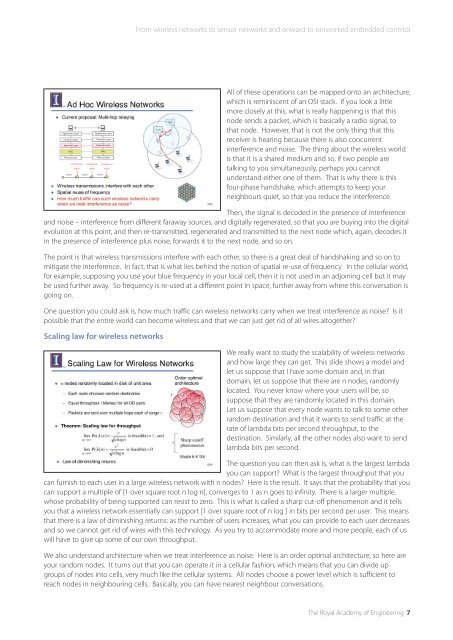Lecture Series in Mobile Telecommunications and Networks (1583KB)
Lecture Series in Mobile Telecommunications and Networks (1583KB)
Lecture Series in Mobile Telecommunications and Networks (1583KB)
You also want an ePaper? Increase the reach of your titles
YUMPU automatically turns print PDFs into web optimized ePapers that Google loves.
From wireless networks to sensor networks <strong>and</strong> onward to networked embedded contrtol<br />
Application Layer<br />
Transport Layer<br />
Network Layer<br />
MAC<br />
Physical Layer<br />
Interference<br />
+<br />
Interference<br />
+<br />
Application Layer<br />
Transport Layer<br />
Network Layer<br />
MAC<br />
Physical Layer<br />
Interference<br />
+<br />
Noise Noise<br />
Noise<br />
Signal Signal Signal<br />
All of these operations can be mapped onto an architecture,<br />
which is rem<strong>in</strong>iscent of an OSI stack. If you look a little<br />
more closely at this, what is really happen<strong>in</strong>g is that this<br />
node sends a packet, which is basically a radio signal, to<br />
that node. However, that is not the only th<strong>in</strong>g that this<br />
receiver is hear<strong>in</strong>g because there is also concurrent<br />
<strong>in</strong>terference <strong>and</strong> noise. The th<strong>in</strong>g about the wireless world<br />
is that it is a shared medium <strong>and</strong> so, if two people are<br />
talk<strong>in</strong>g to you simultaneously, perhaps you cannot<br />
underst<strong>and</strong> either one of them. That is why there is this<br />
four-phase h<strong>and</strong>shake, which attempts to keep your<br />
neighbours quiet, so that you reduce the <strong>in</strong>terference.<br />
Then, the signal is decoded <strong>in</strong> the presence of <strong>in</strong>terference<br />
<strong>and</strong> noise – <strong>in</strong>terference from different faraway sources, <strong>and</strong> digitally regenerated, so that you are buy<strong>in</strong>g <strong>in</strong>to the digital<br />
evolution at this po<strong>in</strong>t, <strong>and</strong> then re-transmitted, regenerated <strong>and</strong> transmitted to the next node which, aga<strong>in</strong>, decodes it<br />
<strong>in</strong> the presence of <strong>in</strong>terference plus noise, forwards it to the next node, <strong>and</strong> so on.<br />
The po<strong>in</strong>t is that wireless transmissions <strong>in</strong>terfere with each other, so there is a great deal of h<strong>and</strong>shak<strong>in</strong>g <strong>and</strong> so on to<br />
mitigate the <strong>in</strong>terference. In fact, that is what lies beh<strong>in</strong>d the notion of spatial re-use of frequency. In the cellular world,<br />
for example, suppos<strong>in</strong>g you use your blue frequency <strong>in</strong> your local cell, then it is not used <strong>in</strong> an adjo<strong>in</strong><strong>in</strong>g cell but it may<br />
be used further away. So frequency is re-used at a different po<strong>in</strong>t <strong>in</strong> space, further away from where this conversation is<br />
go<strong>in</strong>g on.<br />
One question you could ask is, how much traffic can wireless networks carry when we treat <strong>in</strong>terference as noise? Is it<br />
possible that the entire world can become wireless <strong>and</strong> that we can just get rid of all wires altogether?<br />
Scal<strong>in</strong>g law for wireless networks<br />
We really want to study the scalability of wireless networks<br />
<strong>and</strong> how large they can get. This slide shows a model <strong>and</strong><br />
let us suppose that I have some doma<strong>in</strong> <strong>and</strong>, <strong>in</strong> that<br />
doma<strong>in</strong>, let us suppose that there are n nodes, r<strong>and</strong>omly<br />
located. You never know where your users will be, so<br />
suppose that they are r<strong>and</strong>omly located <strong>in</strong> this doma<strong>in</strong>.<br />
Let us suppose that every node wants to talk to some other<br />
r<strong>and</strong>om dest<strong>in</strong>ation <strong>and</strong> that it wants to send traffic at the<br />
rate of lambda bits per second throughput, to the<br />
dest<strong>in</strong>ation. Similarly, all the other nodes also want to send<br />
lambda bits per second.<br />
The question you can then ask is, what is the largest lambda<br />
you can support? What is the largest throughput that you<br />
can furnish to each user <strong>in</strong> a large wireless network with n nodes? Here is the result. It says that the probability that you<br />
can support a multiple of [1 over square root n log n], converges to 1 as n goes to <strong>in</strong>f<strong>in</strong>ity. There is a larger multiple,<br />
whose probability of be<strong>in</strong>g supported can resist to zero. This is what is called a sharp cut-off phenomenon <strong>and</strong> it tells<br />
you that a wireless network essentially can support [1 over square root of n log ] <strong>in</strong> bits per second per user. This means<br />
that there is a law of dim<strong>in</strong>ish<strong>in</strong>g returns: as the number of users <strong>in</strong>creases, what you can provide to each user decreases<br />
<strong>and</strong> so we cannot get rid of wires with this technology. As you try to accommodate more <strong>and</strong> more people, each of us<br />
will have to give up some of our own throughput.<br />
We also underst<strong>and</strong> architecture when we treat <strong>in</strong>terference as noise. Here is an order optimal architecture, so here are<br />
your r<strong>and</strong>om nodes. It turns out that you can operate it <strong>in</strong> a cellular fashion, which means that you can divide up<br />
groups of nodes <strong>in</strong>to cells, very much like the cellular systems. All nodes choose a power level which is sufficient to<br />
reach nodes <strong>in</strong> neighbour<strong>in</strong>g cells. Basically, you can have nearest neighbour conversations.<br />
The Royal Academy of Eng<strong>in</strong>eer<strong>in</strong>g 7

















